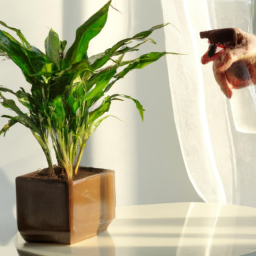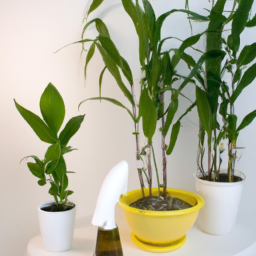
Hey there plant enthusiasts! Are you struggling to keep your air-purifying plants thriving in the dry conditions of your indoor space? Well, fret no more because in this blog post, we’ll be diving into the world of caring for air-purifying plants in dry indoor conditions. Whether you’re a seasoned plant parent or just starting out on your green journey, we’ve got you covered with some helpful tips and tricks to ensure your leafy companions stay happy and healthy. So, grab your watering can and let’s get started on creating a lush oasis in your home!
Caring for Air-Purifying Plants in Dry Indoor Conditions
Understanding the Needs of Air-Purifying Plants in Dry Indoor Conditions
When it comes to creating a healthy and fresh indoor environment, air-purifying plants play a vital role. These plants not only add aesthetic value to your space but also help in filtering out harmful toxins from the air. However, caring for air-purifying plants in dry indoor conditions requires a bit of extra attention. In this guide, we will discuss the specific needs of these plants and provide you with a step-by-step approach to ensure their well-being.
Choosing the Right Air-Purifying Plants
The first step in caring for air-purifying plants in dry indoor conditions is selecting the right species that can thrive in such an environment. Some plants are naturally more tolerant of dry conditions, while others may require higher humidity levels. Here are a few options to consider:
Snake Plant (Sansevieria trifasciata): Snake plants are known for their ability to survive in low-light and dry conditions. They have long, sword-like leaves that can add a touch of elegance to any room.
Spider Plant (Chlorophytum comosum): Spider plants are excellent air purifiers and can tolerate a wide range of indoor conditions, including dry air. They have cascading foliage that adds a unique visual appeal.
Peace Lily (Spathiphyllum wallisii): Peace lilies are not only beautiful but also efficient at removing toxins from the air. They prefer slightly higher humidity levels but can adapt to drier conditions with proper care.
Providing Adequate Watering
One of the key aspects of caring for air-purifying plants in dry indoor conditions is ensuring proper watering. While it’s essential to avoid overwatering, it’s equally crucial not to let the soil dry out completely. Here are some guidelines to follow:
1. Check soil moisture: Use your finger to assess the moisture level of the soil. If the top inch feels dry, it’s time to water the plant. However, if it still feels slightly moist, wait a day or two before watering.
2. Water thoroughly: When watering, make sure to thoroughly moisten the soil until water drains out from the bottom of the pot. This ensures that the entire root system receives adequate hydration.
3. Avoid waterlogging: While it’s essential to water your plants, it’s equally important to prevent waterlogging. Ensure that the pots have drainage holes to allow excess water to escape. Standing water can lead to root rot and other issues.
Creating a Humid Microclimate
In dry indoor conditions, it’s crucial to create a humid microclimate around your air-purifying plants. This can be achieved through the following methods:
1. Group plants together: Placing multiple plants together can increase humidity levels as they collectively release moisture through transpiration. This also creates a visually appealing display.
2. Use a pebble tray: Fill a shallow tray with water and place pebbles or stones in it. Then, position your plants on top of the pebbles. As the water evaporates, it increases humidity around the plants.
3. Mist the leaves: Regularly misting the leaves of your air-purifying plants can help mimic the natural humidity they would experience in their native environments. Use a spray bottle to lightly mist the foliage, avoiding excessive moisture on the soil.
By following these steps, you can ensure that your air-purifying plants thrive in dry indoor conditions. Remember to choose the right plants, provide adequate watering, and create a humid microclimate. With proper care, your air-purifying plants will not only beautify your space but also contribute to a healthier living environment.

Caring for Air-Purifying Plants in Dry Indoor Conditions
Choosing the Right Air-Purifying Plants for Dry Indoor Environments
Indoor air quality is a significant concern, especially in dry environments. Luckily, there are air-purifying plants that can thrive in such conditions and help improve the air you breathe. When selecting air-purifying plants for your dry indoor environment, it is essential to consider their adaptability to low humidity levels and their ability to effectively filter pollutants.
Understanding Adaptability to Low Humidity Levels
Plants that can tolerate low humidity levels are more likely to thrive in dry indoor conditions. These plants have evolved to survive in arid environments and are better equipped to handle low moisture levels. Some examples of air-purifying plants that are well-suited for dry indoor environments include:
1. Snake Plant (Sansevieria trifasciata)
The Snake Plant is a popular choice for dry indoor environments due to its ability to tolerate low humidity. It has long, upright leaves that are green with yellow edges, making it an attractive addition to any room. This plant is known for its air-purifying qualities, as it filters out toxins such as formaldehyde and benzene.
2. Aloe Vera (Aloe barbadensis)
Aloe Vera is not only a versatile plant with various medicinal uses but also an excellent air purifier. It thrives in dry conditions and requires minimal maintenance. Aloe Vera releases oxygen at night, making it a perfect choice for bedrooms.
3. Spider Plant (Chlorophytum comosum)
The Spider Plant is a resilient plant that can adapt to a wide range of environments, including dry indoor conditions. It has long, arching leaves with white stripes, adding a touch of elegance to any space. This plant effectively removes harmful pollutants like formaldehyde and xylene from the air.
Effective Air Filtration
When selecting air-purifying plants, it is crucial to consider their ability to filter pollutants effectively. The following plants are known for their exceptional air-cleansing properties:
1. Peace Lily (Spathiphyllum wallisii)
The Peace Lily is a beautiful plant with glossy, dark green leaves and elegant white flowers. It is highly effective at removing common indoor pollutants such as formaldehyde, benzene, and trichloroethylene. This plant requires slightly higher humidity levels, so misting the leaves can help maintain its health in dry indoor conditions.
2. Boston Fern (Nephrolepis exaltata)
The Boston Fern is a classic choice for improving indoor air quality. It has feathery fronds that add a touch of lushness to any room. This plant excels at removing formaldehyde, xylene, and toluene from the air. To keep the Boston Fern healthy in dry conditions, consider using a humidifier or placing a tray of water near the plant to increase humidity.
3. Bamboo Palm (Chamaedorea seifrizii)
The Bamboo Palm is a tropical plant that thrives in low light and dry conditions. It is highly effective at removing formaldehyde, benzene, and carbon monoxide from the air. This plant adds a touch of elegance to any space with its lush, arching fronds.
Caring for Air-Purifying Plants in Dry Indoor Conditions
Now that you have chosen the right air-purifying plants for your dry indoor environment, it is essential to provide them with the care they need to thrive. Here are some tips to ensure the health and longevity of your plants:
1. Proper Watering: While it’s crucial not to overwater your plants, it’s equally important not to let them dry out completely. Check the soil moisture regularly and water when the top inch feels dry. Use room temperature water and ensure good drainage to prevent waterlogged roots.
2. Adequate Sunlight: Most air-purifying plants thrive in bright, indirect sunlight. Place them near a window where they can receive sufficient light without being exposed to direct sunlight, which can scorch their leaves.
3. Maintain Humidity: Dry indoor conditions can be challenging for some air-purifying plants. Increase humidity levels by misting the leaves with water or placing a tray filled with water near the plants. Grouping plants together can also create a microclimate with higher humidity.
4. Regular Dusting: Dust can accumulate on the leaves of your air-purifying plants, hindering their ability to photosynthesize effectively. Wipe the leaves gently with a damp cloth or use a soft brush to remove dust regularly.
5. Avoid Drafts: Air drafts, such as those from open windows or air conditioning vents, can cause stress to your plants. Keep them away from such drafts to prevent leaf damage and ensure their overall well-being.
By choosing air-purifying plants that can thrive in dry indoor conditions and providing them with proper care, you can create a healthier and more pleasant living environment. Remember to observe your plants closely and adjust their care routine as needed. Enjoy the benefits of cleaner air and the beauty of indoor greenery!

3. Tips and Techniques for Caring for Air-Purifying Plants in Dry Indoor Conditions
Indoor air pollution is a common problem in many households, especially in dry indoor conditions. Air-purifying plants can be a great addition to your home or office space, as they not only add a touch of greenery but also help in improving the air quality. However, caring for these plants in dry indoor conditions requires some special attention. In this guide, we will discuss some tips and techniques to ensure your air-purifying plants thrive in such conditions.
Understanding the Needs of Air-Purifying Plants
Before diving into the care tips, it’s important to understand the needs of air-purifying plants. These plants typically come from tropical or subtropical regions where humidity levels are higher. Therefore, they are more accustomed to moist environments. In dry indoor conditions, the air tends to be drier, which can have a negative impact on the health of these plants.
One of the key needs of air-purifying plants is humidity. They thrive in environments with higher humidity levels, as it helps in maintaining their overall health and vitality. Dry indoor conditions can cause the leaves of these plants to dry out, leading to wilting and even plant death. Therefore, it’s crucial to provide the necessary humidity to ensure their well-being.
Another important aspect to consider is the watering requirements of air-purifying plants. While dry indoor conditions can make the soil dry out faster, it’s essential not to overwater them. Overwatering can lead to root rot and other fungal diseases, which can be detrimental to the health of the plants. Striking the right balance between providing adequate moisture and avoiding excessive watering is essential for their care.
Creating a Suitable Environment
Now that we understand the needs of air-purifying plants, let’s discuss how to create a suitable environment for them in dry indoor conditions.
1. Increase Humidity: As mentioned earlier, air-purifying plants thrive in higher humidity levels. To increase humidity, you can use a humidifier in the room where the plants are located. Alternatively, you can place a tray filled with water near the plants or mist them regularly with water to create a humid microclimate around them.
2. Provide Indirect Sunlight: While these plants require light to carry out photosynthesis, direct sunlight in dry indoor conditions can cause the leaves to dry out faster. It’s best to place them in an area where they receive bright, indirect sunlight. This can be near a window with sheer curtains or a few feet away from a well-lit room.
3. Choose the Right Potting Mix: The choice of potting mix is crucial for air-purifying plants in dry indoor conditions. Opt for a well-draining mix that retains moisture without becoming waterlogged. Adding organic matter like peat moss or coconut coir can help improve water retention while allowing excess water to drain out.
Watering and Maintenance
Proper watering and maintenance are essential for the well-being of air-purifying plants in dry indoor conditions.
1. Watering: As mentioned earlier, finding the right balance is key when it comes to watering air-purifying plants. Check the moisture level of the soil regularly by inserting your finger about an inch deep into the soil. If it feels dry, it’s time to water the plant. However, avoid overwatering by ensuring the excess water drains out properly.
2. Pruning: Regular pruning helps maintain the shape and size of air-purifying plants. It also allows for better air circulation, reducing the risk of fungal diseases. Remove any dead or yellowing leaves and trim back overgrown branches to promote new growth and overall plant health.
3. Dusting: Dust can accumulate on the leaves of air-purifying plants, hindering their ability to carry out photosynthesis effectively. Wipe the leaves gently with a damp cloth or use a soft brush to remove the dust regularly. This will not only improve their appearance but also enhance their air-purifying capabilities.
Caring for air-purifying plants in dry indoor conditions requires attention to detail and a little extra effort. By understanding their needs, creating a suitable environment, and providing proper watering and maintenance, you can ensure these plants thrive and continue to purify the air in your living or working space. So, go ahead and bring some greenery into your indoor environment while enjoying cleaner and fresher air!
Summary Snapshot
Air-purifying plants are a fantastic addition to any indoor space, as they not only add a touch of greenery but also help to improve air quality by filtering out toxins. However, caring for these plants can be a bit challenging, especially in dry indoor conditions. In such environments, it is crucial to provide the right amount of moisture and create a suitable microclimate for these plants to thrive.
To ensure the well-being of your air-purifying plants in dry indoor conditions, proper watering is key. While it might be tempting to water them frequently, overwatering can be detrimental. Instead, it is advisable to check the moisture level of the soil regularly by sticking your finger about an inch deep into it. If it feels dry, it’s time to water. However, be cautious not to let the plants sit in standing water, as this can lead to root rot. Additionally, misting the leaves with water can provide a much-needed boost of humidity, especially during drier months or in rooms with low humidity levels. This simple step can help mimic the natural conditions these plants thrive in, promoting their overall health.
Your Questions Answered. Comprehensive FAQ:
Q1: What are air-purifying plants?
A1: Air-purifying plants are indoor plants that have the ability to remove toxins and pollutants from the air, making the surrounding environment cleaner and healthier to breathe. These plants are known for their natural air-filtering properties and can help improve indoor air quality.
Q2: How do air-purifying plants work?
A2: Air-purifying plants work through a process called phytoremediation. They absorb harmful gases and chemicals from the air through their leaves and roots and convert them into harmless substances. This natural process helps to reduce indoor pollution levels and create a more breathable atmosphere.
Q3: What are the best air-purifying plants for dry indoor conditions?
A3: Some air-purifying plants are better suited for dry indoor conditions due to their ability to tolerate lower humidity levels. Examples of such plants include the Snake Plant, Spider Plant, Aloe Vera, and ZZ Plant. These plants have adapted to survive in arid environments and can thrive in drier indoor conditions.
Q4: How do I care for air-purifying plants in dry indoor conditions?
A4: Caring for air-purifying plants in dry indoor conditions requires a few key considerations. Firstly, it’s important to provide adequate watering to prevent the soil from drying out completely. However, be cautious not to overwater, as this can lead to root rot. Additionally, placing a humidifier nearby or misting the plants occasionally can help increase humidity levels. Lastly, ensure the plants receive sufficient indirect sunlight and avoid placing them near drafty areas or heating vents.
Q5: Can air-purifying plants improve the air quality in dry indoor environments?
A5: Yes, air-purifying plants can certainly improve air quality even in dry indoor environments. While these plants may not increase the humidity levels directly, they effectively remove harmful pollutants from the air, making it cleaner and healthier to breathe. By reducing levels of toxins and improving overall air quality, air-purifying plants contribute to a more comfortable and refreshing indoor environment, even in dry conditions.
Dr. Olivia Green is a botanist with over two decades of experience in indoor plant cultivation. She holds a Ph.D. in Plant Biology and has dedicated her career to researching plant behavior in controlled environments. Dr. Green is passionate about helping plant enthusiasts master the art of indoor gardening through her extensive knowledge and practical insights.


